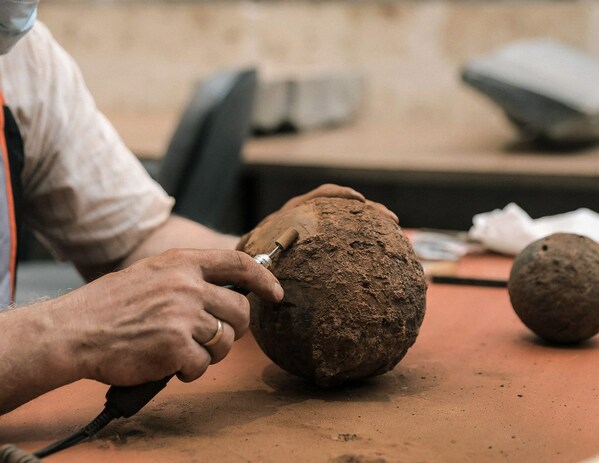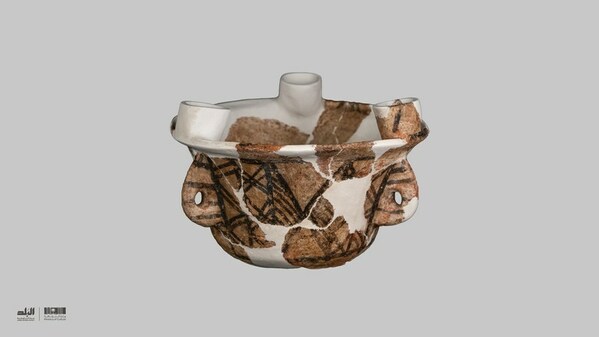JEDDAH, Saudi Arabia, Feb. 5, 2024 /PRNewswire/ -- Jeddah Historic District Program in cooperation with the Heritage Commission announced the discovery of 25.000 fragments of artifacts, the oldest of which dates from the first two centuries AH (from the 7th to the 8th centuries AD). The fieldwork was conducted on 4 different sites: Othman bin Affan Mosque (may Allah be pleased with him), Al-Shona, the Eastern Moat, and a segment of the Northern Wall, under the framework of the Archeology Project which is supervised by Jeddah Historic District Program.

The announcement of the archeological discoveries is part of the efforts the Historic Jeddah Revival Project had made, and which was launched by His Royal Highness, the Crown Prince Mohammed bin Salman bin Abdulaziz. The Archaeology Project aims to preserve national antiquities and archaeological sites, unveil the history embedded in the Kingdom's lands, and support Historic Jeddah as a cultural and touristic center to further achieve the Saudi Vision (2030).
Archaeological survey and excavations, conducted in November 2020, resulted in the discovery of 11.405 pottery sherds which weigh 293 kg, 11.360 animal bones of 107 kg, 1.730 shells of 32 kg. In addition to 685 building materials which weigh 87 kg, as well as 187 glass artifacts which weigh 5kg and 71 metal artifacts of 7kg. The total weight of the archaeological materials found is 531kg which constitute a valuable addition to the Saudi archaeological discoveries.
Archaeological investigations in Othman bin Affan Mosque—may Allah be pleased with him—revealed the archeological discoveries. The oldest of which dates back to the first two centuries AH (from the 7th to the 8th centuries AD), passing through the early Islamic era, the Umayyad era, the Abbasid era, then the Mamluk era, and onto the modern times (i.e., the early 15th century AH / the 21st century AD). Further, analyses conducted on ebony pillars found on the sides of the Mihrab revealed that these pillars likely date back to the first two centuries AH (the 7th to the 8th centuries AD). The wood's origin has been identified to be Ceylon Island in the Indian Ocean which highlights the far-reaching trade connections of Historic Jeddah.
In addition, the fragments of artifacts discovered in Othman bin Affan Mosque contain a variety of ceramic vessels and pieces of high-quality porcelain, among of which are some pieces made in the Chinese province of Jiangxi, that potentially date back to the 10th and 13th centuries AH (the 16th to 19th centuries AD), as well as some older pottery fragments dating back as far as the Abbasid era.
Meanwhile, at Al-Shona, the chronology of the site dates back at least to the 13th century AH (19th century AD) with indications of archaeological remains that could be as old as the 10th century AH (16th century AD). Numerous pottery sherds have been found at the site, comprising porcelain and other ceramics from Europe, Japan, and China, dating back to the 13th and the 14th centuries AH (the 19th to 20th centuries AD).
Also, excavations at Al-Kidwah ("Bab Makkah" - Makkah gate) revealed parts of the Eastern Moat which most likely date back to the late 12th century AH (late 18th century AD).
Moreover, several tombstones of Mangabi stone, marble, and granite were also found in different locations in Historic Jeddah. The tombstones have inscriptions of names, epitaphs, and verses of the Quran which likely date back to the 2nd and 3rd centuries AH (8th and 9th centuries AD), and are still under thorough study by specialists.
Archaeological studies of the four historical sites included excavations, radiocarbon analysis, soil analyses, geophysical surveys, and scientific studies of the discovered artifacts. Additionally, more than 250 wood samples were taken from 52 buildings and transferred to be studied in specialized international laboratories for identification and dating. Furthermore, the international archival research resulted in the collection of more than 984 historical documents on Historic Jeddah, including historical maps and drawings of the Jeddah City Wall, Al-Shona, and other parts of Historic Jeddah, which are being studied thoroughly and attentively.
Jeddah Historic District Program in cooperation with the Heritage Commission supervised the documentation, registration, and preservation of archaeological artifacts discovered in Historic Jeddah, and listed the finds in the National Archaeological Register. Also, scientific databases were created to protect and preserve the information about the discovered artifacts. It is noteworthy that archaeological documentation and photography for the archive were conducted by a group of national competencies specialized in the conservation and registration of archaeological fragments.
The work of the Historic Jeddah project began in Jumada Al-Awwal, January 2020, with the preparation of exploratory studies and a geophysical survey to reveal the history embedded in the four locations, including the Othman bin Affan mosque, Al-Shona, a segment of the Northern Wall, and Al-Kidwah.
Link to attached pictures
https://www.dropbox.com/scl/fo/qvtnekex0tee6izeu76vc/h?rlkey=2tg2710nmee4hchlecezq2fiq&dl=0







